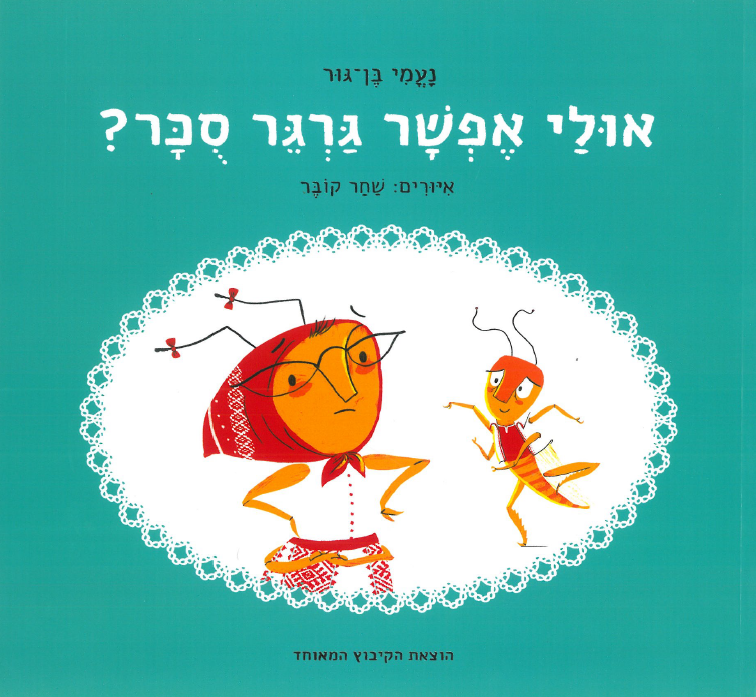אולי אפשר גרגר סוכר?
מאת: נעמי בן-גור איורים: שחר קובר
Не одолжите ли крупинку сахара?
Наоми Бен Гур
Иллюстрации: Шахар Ковер
Дорогие родители!
Всю неделю трудолюбиваямуравьиха усердно готовится к субботе. А сверчок проводит это время в песнях и танцах. Когда сверчок решил приготовить торт в честь субботы, ему понадобилась помощь муравьихи, однако оказалось, что и он смог помочь ей.
"Колесо,что вращается в мире" (Вавилонский Талмуд 151,72)
Взаимная помощь и любовь к ближнему – это основа мира. Они делают мир вокруг нас лучше и добрее. Не всегда мы знаем, кому и когда понадобится наша помощь. Муравьиха и сверчок отличаются друг от друга по своему характеру, но они живут в дружбе и в добрососедских отношениях, они проявляют щедрость, помогают друг другу, вместе проводят время – они друзья! В конце концоввы увидите, что у каждого из них есть возможность помочь другу.
Занятия в кругу семьи
- Можно предложить детям полистать книжку и рассказать ее содержание своими словами по картинкам. Стоит вместе рассмотреть иллюстрации и найти все детали, которые художник добавил к тексту рассказа. Рассмешило ли вас что-нибудь на картинках? Были ли на них какие-нибудь предметы, которые ваши дети не узнали? Попросите их указать на все картинки, которые показывают, как муравьиха и сверчок помогают друг другу. После этого можно вместе нарисовать их такими, как вы их представляете. Интересно, вы тоже решили нарисовать муравьиху в очках?
- "Пойди к муравью, ленивец, посмотри на пути его, и сделайся мудрым" (Мишлей 6,6). Можно побеседовать о чертах характера муравьихи и сверчка в книжке. Муравьихатрудолюбивая и прилежная, а сверчок любит петь и танцевать. По следам рассказа можно поговорить о чертах характера и склонностях членов семьи и отметить особый вклад каждого в жизнь семьи.
- "Лучше сосед вблизи, нежели брат вдали"(Мишлей 27, 10). А кто ваши соседи? Помогаете ли вы друг другу? Прочитав рассказ, можно придумать с детьми что-нибудь, что могло бы порадовать соседей или близких людей, и вместе выполнить это. Что вы после этого почувствовали? Почувствовали ли вы тоже, что иногда "лучше давать, чем получать", как сказала муравьиха?
- Вам, конечно, знакома басня Крылова о стрекозе и муравье? В этой басне стрекоза приходит попросить у муравья еду, потому что она все время была занята пением и не позаботилась о запасах на зиму, а муравей ей отказывает. Можно рассказать эту басню детям и сравнить ее с нашим рассказом. Какой вариант им понравился больше? Почему? (Возможно, вы знакомы и с другими вариантами этой басни, например, Эзопа и Лафонтена, и знаете, что в разных вариантах компаньоном муравья являются жук, цикада и кузнечик.Как вы думаете, почему?)
- "Колесо, что крутится в мире": иногда дети чувствуют несправедливость в жизни семьи, например, когда их просят помочь по дому, а братьев и сестер - нет. Можно побеседовать с детьми о том, как муравьиха отнеслась к просьбе сверчка, и спросить их, что, по их мнению, она чувствовала, после того, что она собирала еду всю неделю, а теперь сверчок просит у нее об одолжении. Важно обратить внимание, что в конце концов и муравьиха выиграла из-за того, что помогла сверчку. Так и в семье – есть много возможностей помочь и получить помощь от каждого по его умению и тогда, когда он это может сделать.
- Вы тоже можете испечь торт к субботе! Приятно вместе поработать на кухне, а еще приятнее поделиться делом рук своих с соседями или с членами семьи. Можно пригласить соседей или друзей попробовать торт, вместе попеть, совсем как муравьиха и сверчок в рассказе.
Рецепт апельсинового торта
Ингредиенты:
150 грамм масла или маргарина,
1 стакан сахара,
4 взбитых яйца,
1 чайная ложка ванильного сахара или ванильной эссенции,
цедра с двух апельсинов,
1 стакан выжатого апельсинового сока,
2.5 стакана муки,
3 чайные ложки разрыхлителя теста,
Сахарная пудра для украшения.
Процесс приготовления:
Взбиваем вместе масло и сахар.
Добавляем яйца, ваниль и цедру и продолжаем взбивать.
Добавляем апельсиновый сок, муку, разрыхлитель теста и перемешиваем до тех пор, пока не получится воздушная и однородная смесь.
Перекладываем эту смесь в смазанную маслом формочку и выпекаем в течение 45 – 35 минут при температуре 170 градусов.
Остужаем торт и посыпаем его тонким слоем сахарной пудры.
Приятного аппетита и шаббатшалом!











